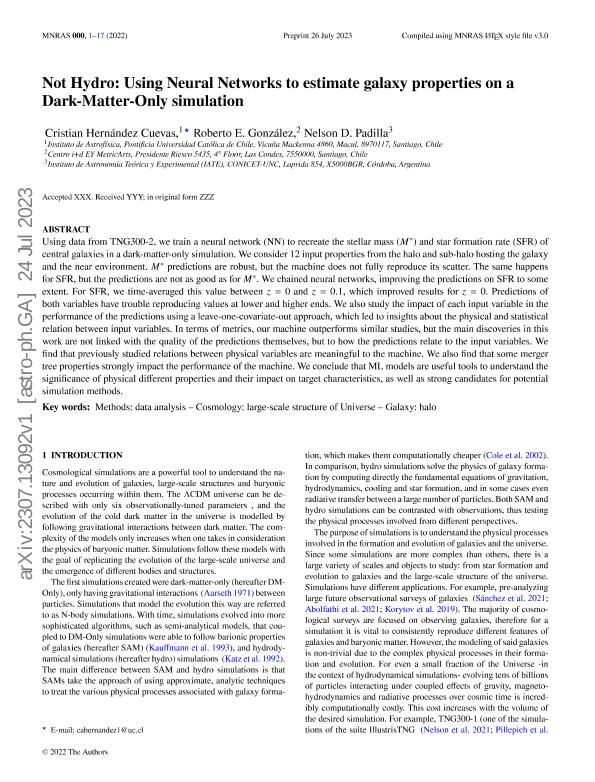Mostrar el registro sencillo del ítem
dc.contributor.author
Hernández, Cristian A.
dc.contributor.author
González, Roberto E.
dc.contributor.author
Padilla, Nelson David

dc.date.available
2024-02-08T10:50:23Z
dc.date.issued
2023-09
dc.identifier.citation
Hernández, Cristian A.; González, Roberto E.; Padilla, Nelson David; Not hydro: Using neural networks to estimate galaxy properties on a dark-matter-only simulation; Oxford University Press; Monthly Notices of the Royal Astronomical Society; 524; 3; 9-2023; 4653-4669
dc.identifier.issn
0035-8711
dc.identifier.uri
http://hdl.handle.net/11336/226258
dc.description.abstract
Using data from TNG300-2, we train a neural network (NN) to recreate the stellar mass (M∗) and star formation rate (SFR) of central Galaxies in a dark-matter-only simulation. We conider 12 input properties from the halo and sub-halo hosting the galaxy and the near environment. M∗ predictions are robust, but the machine does not fully reproduce its scatter. The same happens for SFR, but the predictions are not as good as for M∗. We chained NNs, improving the predictions on SFR to some extent. For SFR, we time-Averaged this value between z = 0 and z = 0.1, which improved results for z = 0. Predictions of both variables have trouble reproducing values at lower and higher ends. We also study the impact of each input variable in the performance of the predictions using a leave-one-covariate-out approach, which led to insights about the physical and statistical relation between input variables. In terms of metrics, our machine outperforms similar studies, but the main discoveries in this work are not linked with the quality of the predictions themselves, but to how the predictions relate to the input variables. We find that previously studied relations between physical variables are meaningful to the machine. We also find that some merger tree properties strongly impact the performance of the machine. We conclude that machine learning models are useful tools to understand the significance of physical different properties and their impact on target characteristics, as well as strong candidates for potential simulation methods.
dc.format
application/pdf
dc.language.iso
eng
dc.publisher
Oxford University Press

dc.rights
info:eu-repo/semantics/openAccess
dc.rights.uri
https://creativecommons.org/licenses/by-nc-sa/2.5/ar/
dc.subject
COSMOLOGY: LARGE-SCALE STRUCTURE OF UNIVERSE
dc.subject
GALAXIES: STAR FORMATION
dc.subject
GALAXIES: STELLAR CONTENT
dc.subject
METHODS: DATA ANALYSIS
dc.subject
METHODS: NUMERICAL
dc.subject.classification
Astronomía

dc.subject.classification
Ciencias Físicas

dc.subject.classification
CIENCIAS NATURALES Y EXACTAS

dc.title
Not hydro: Using neural networks to estimate galaxy properties on a dark-matter-only simulation
dc.type
info:eu-repo/semantics/article
dc.type
info:ar-repo/semantics/artículo
dc.type
info:eu-repo/semantics/publishedVersion
dc.date.updated
2024-02-08T10:19:24Z
dc.journal.volume
524
dc.journal.number
3
dc.journal.pagination
4653-4669
dc.journal.pais
Reino Unido

dc.journal.ciudad
Oxford
dc.description.fil
Fil: Hernández, Cristian A.. Pontificia Universidad Católica de Chile; Chile
dc.description.fil
Fil: González, Roberto E.. Centro i + d EY MetricArts; Chile
dc.description.fil
Fil: Padilla, Nelson David. Consejo Nacional de Investigaciones Científicas y Técnicas. Centro Científico Tecnológico Conicet - Córdoba. Instituto de Astronomía Teórica y Experimental. Universidad Nacional de Córdoba. Observatorio Astronómico de Córdoba. Instituto de Astronomía Teórica y Experimental; Argentina
dc.journal.title
Monthly Notices of the Royal Astronomical Society

dc.relation.alternativeid
info:eu-repo/semantics/altIdentifier/doi/http://dx.doi.org/10.1093/mnras/stad2112
dc.relation.alternativeid
info:eu-repo/semantics/altIdentifier/url/https://academic.oup.com/mnras/article/524/3/4653/7224004
dc.relation.alternativeid
info:eu-repo/semantics/altIdentifier/arxiv/https://arxiv.org/abs/2307.13092
Archivos asociados
